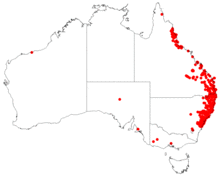| Allocasuarina torulosa | |
|---|---|
 | |
| Allocasuarina torulosa | |
| Scientific classification | |
| Kingdom: | Plantae |
| Clade: | Tracheophytes |
| Clade: | Angiosperms |
| Clade: | Eudicots |
| Clade: | Rosids |
| Order: | Fagales |
| Family: | Casuarinaceae |
| Genus: | Allocasuarina |
| Species: | A. torulosa |
| Binomial name | |
| Allocasuarina torulosa | |
 | |
| Occurrence data from AVH | |
Allocasuarina torulosa, the rose she-oak or forest oak, is a tree which grows in sub-rainforest (just outside the main forest area) of Queensland and New South Wales, Australia. Originally described as Casuarina torulosa by William Aiton, it was moved to its current genus in 1982 by Australian botanist Lawrie Johnson.[1] It is the type species of the genus Allocasuarina.
The timber is reddish pink to brown. It is prized by woodworkers and woodturners as a rare and exotic timber, often used in wood turnings, knife handles and other specialist items.
It grows from seed, and cut or broken trees will often regenerate from the trunk.
The rose she-oak has the largest contraction along the grain (12%) of any Australian wood and needs to be dried carefully to get full value as a useful timber.
References
- ^ "Allocasuarina torulosa". Australian Plant Name Index (APNI), IBIS database. Centre for Plant Biodiversity Research, Australian Government.
External links
- . New International Encyclopedia. 1905.
- Occurrence data for Allocasuarina torulosa from The Australasian Virtual Herbarium
